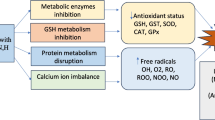Abstract
IT is now well established that the parenteral administration of large doses of œstrogens to mice results in the deposition of new bone in the marrow cavities. This change is most pronounced in the long bones. Here the new bone is first laid down at both extremities on the trabeculæ of the spongiosa and then, becoming more compact, it extends along the longitudinal axis of the shaft towards the centre of the marrow cavity. Among mammals this response to œstrogens is peculiar to the mouse. It has provided us with an important method for studying the factors which influence bone formation.
Similar content being viewed by others
References
Gardner, W. O., and Pfeiffer, C. A., Anat. Rec., 73, 21, Supp. (1939).
Urist, M. R., Budy, A. M., and McLean, F. C., Amer. J. Bone and Joint Surgery, 32, a, 143 (1950).
Author information
Authors and Affiliations
Rights and permissions
About this article
Cite this article
BARKER, D., CROSSLEY, J. Effect of Testosterone on Œstrogen-induced Bone Formation in Mice. Nature 194, 1088–1089 (1962). https://doi.org/10.1038/1941088a0
Issue Date:
DOI: https://doi.org/10.1038/1941088a0
- Springer Nature Limited
This article is cited by
-
Autoradiographische Untersuchungen über die Zellkinetik der enchondralen Ossifikation der Maus nach Oestrogen- und Testosteronverabreichung
Zeitschrift für Die Gesamte Experimentelle Medizin (1965)





